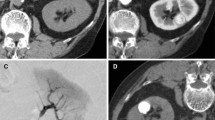Abstract
We describe a new emergency interventional radiology approach in percutaneous procedure complications. We present the case of an 81-year-old male with small renal cancer, approached with percutaneous radiofrequency ablation (RTA) and complicated by pseudoaneurysm bleeding of a renal artery branch. In the emergency setting, pseudoaneurysm was treated in the CT room by the same RTA needle, without any complications or local tumor recurrence during the next 6-month follow-up.





Similar content being viewed by others
References
Miller DC, Faerber GJ (2001) Arterial pseudoaneurysm complicating endoscopic fulguration of upper urinary tract urothelial carcinoma. Urology 58:799
Ngo TC, Joy Lee J (2010) Gonzalo MLRenal pseudoaneurysm: an overview. Nat Rev Urol 7:619–625
Hui GC, Tuncali K, Tatli S, Morrison PR, Silverman SG (2008) Comparison of percutaneous and surgical approaches to renal tumor ablation: meta-analysis of effectiveness and complication rates. J Vasc Interv Radiol 19:1311–1320
Thumar AB, Trabulsi EJ, Lallas CD (2010) Brown DBThermal ablation of renal cell carcinoma: triage, treatment, and follow-up. J Vasc Interv Radiol 21:S233–S241
Park BK, Kim CK (2009) Complications of image-guided radiofrequency ablation of renal cell carcinoma: causes, imaging features, and prevention methods. Eur Radiol 19:2180–2190
Gupta V, Galwa R, Khandelwal N, Bapuraj JR (2008) Postpyelolithotomy renal artery pseudoaneurysm management with percutaneous thrombin injection: a case report. Cardiovasc Intervent Radiol 31:422–426
Schellhammer F, Meyer M, Oette M (2016) Percutaneous trans-needle coil application—an alternative access to false aneurysm of the splenic artery. Vasa 45:253–254
Lal A et al. (2009) Percutaneous cyanoacrylate glue injection into the renal pseudoaneurysm to control intractable hematuria after percutaneous nephrolithotomy. Cardiovasc Intervent Radiol 32:767–771
Author information
Authors and Affiliations
Corresponding author
Ethics declarations
Conflict of interest
The authors declare that they have no conflict of interest.
Rights and permissions
About this article
Cite this article
Faiella, E., Frauenfelder, G., Santucci, D. et al. Percutaneous radiofrequency ablation of a bleeding pseudoaneurysm during CT-guided renal cancer treatment. A case report. Emerg Radiol 23, 527–530 (2016). https://doi.org/10.1007/s10140-016-1432-z
Received:
Accepted:
Published:
Issue Date:
DOI: https://doi.org/10.1007/s10140-016-1432-z




